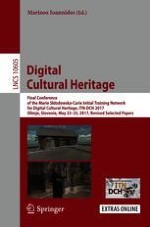2018 | OriginalPaper | Buchkapitel
Exploring Cultural Heritage Using Virtual Reality
verfasst von : Laurent Debailleux, Geoffrey Hismans, Natacha Duroisin
Erschienen in: Digital Cultural Heritage
Aktivieren Sie unsere intelligente Suche, um passende Fachinhalte oder Patente zu finden.
Wählen Sie Textabschnitte aus um mit Künstlicher Intelligenz passenden Patente zu finden. powered by
Markieren Sie Textabschnitte, um KI-gestützt weitere passende Inhalte zu finden. powered by
